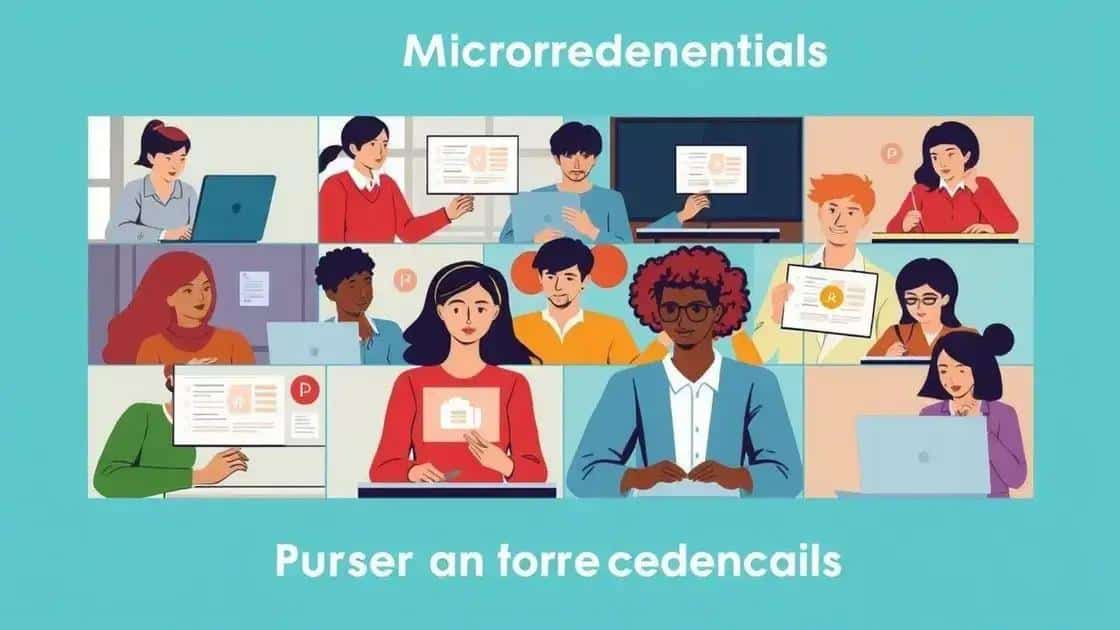Insights on microcredential education paths: What you need to know

Microcredential education paths offer targeted skills and flexible learning options, enhancing employability and allowing individuals to stay competitive in rapidly changing job markets.
Insights on microcredential education paths are shaping the future of learning and career development. Curious about how these programs can elevate your skills? Let’s dive into what makes them so valuable.
Understanding microcredential education
Understanding microcredential education is essential for anyone looking to enhance their skills and boost their career. These short, focused programs provide valuable knowledge in specific areas.
What are Microcredentials?
Microcredentials are certifications that demonstrate skill mastery in a specific subject. They are increasingly popular as people seek ways to stand out in a competitive job market. Unlike traditional degrees, microcredentials are flexible and often can be completed quickly.
Benefits of Microcredential Programs
- They offer targeted learning opportunities.
- Many programs are accessible online.
- They can enhance your resume and marketability.
- They are often more affordable than traditional education.
Microcredential programs cater to various fields, from technology to business management. This flexibility allows learners to gain expertise that aligns with their career goals. As industries evolve, so do the skills required. Microcredentials ensure that learners stay current and relevant.
Furthermore, these programs often include real-world applications. Many courses feature projects or collaborations with industry professionals. This approach helps learners develop practical skills that employers value, bridging the gap between education and employment.
How to Get Started
Getting started with microcredential education is easy. First, identify your interests and career goals. Next, research programs that offer credentials in those areas. Consider the following:
- Check course reviews and ratings.
- Evaluate the instructors’ qualifications.
- Look for partnerships with reputable companies.
- Assess the format to ensure it fits your schedule.
Many platforms provide microcredentialing options, such as online universities and learning sites. Choose one that aligns with your learning style. The key to success is to remain motivated and engage fully with the material.
Through microcredential education, learners can gain essential skills quickly. These credentials not only enhance your knowledge but also boost your confidence in the workplace. Embracing this modern approach to education can truly change the way you advance your career.
Benefits of pursuing microcredentials

Pursuing microcredentials offers numerous advantages that can greatly impact your career path. These programs are designed to provide focused learning opportunities, helping you to quickly gain relevant skills.
Enhance Your Skills
One of the primary benefits of microcredential education is skill enhancement. By completing specific courses, you can improve your knowledge in desired areas. This targeted approach allows you to become proficient without the time commitment of traditional degree programs.
Career Advancement
Another advantage is the potential for career advancement. Employers often look for candidates who have demonstrated a commitment to learning. Having microcredentials on your resume can set you apart and show that you are proactive about expanding your abilities. This can lead to job promotions or new job opportunities.
- Microcredentials can make you more competitive in the job market.
- They signal to employers that you have specialized knowledge.
- Such credentials can open doors to new career paths.
- Employers often value practical skills over theoretical knowledge.
Additionally, pursuing microcredentials can be flexible and convenient. Many programs are offered online, allowing you to learn at your own pace. This means you can integrate your studies with work and personal commitments seamlessly. As you complete courses, you’ll find it easier to balance learning with other responsibilities.
Furthermore, microcredentials often involve collaboration with industry leaders. This connection can help you network and build relationships while you learn. Networking is crucial as it increases your visibility in your field and helps you connect with potential employers or mentors.
Cost-Effectiveness
Another significant benefit is the cost-effectiveness of microcredential programs. Generally, they are much cheaper than traditional degrees. This affordability allows you to invest in your education without incurring substantial debt. Many learners appreciate this aspect, as it makes furthering their education more accessible.
In summary, the benefits of pursuing microcredentials are clear. With skill enhancement, career advancement, flexibility, and cost-effectiveness, they present a compelling option for anyone looking to boost their qualifications.
How to choose the right microcredential path
Choosing the right microcredential path can feel overwhelming, but with some guidance, it becomes manageable. First, consider your career goals and interests. Understanding what you want to achieve will help narrow down your options.
Identify Your Goals
Before deciding on a microcredential, reflect on your professional aspirations. Ask yourself questions like:
- What skills do I need to advance my career?
- Which industries am I interested in?
- How much time can I dedicate to studying?
Identifying your goals helps you find programs aligned with your objectives. Each microcredential focuses on different skills, so knowing what you need is essential.
Research Available Programs
Once you have your goals set, research available microcredential programs. Look for options from reputable institutions. Online learning platforms often provide detailed course descriptions, showing exactly what you’ll learn. Pay attention to the following:
- Course content and structure.
- Instructor expertise and background.
- Reviews from previous students.
- Cost and duration of the program.
This process may take time, but it ensures you choose a quality program that fits your needs. Don’t hesitate to reach out to support teams at educational platforms for additional information or clarifications.
Another important factor to consider is accreditation. Ensure that the microcredentials you are interested in are recognized by employers. This can significantly impact how valuable these credentials are in the job market. If you want to maximize your investment, focus on programs held in high regard by industry leaders.
Consider Program Format and Flexibility
Taking into account how you prefer to learn is also crucial. Many microcredential programs offer online formats, allowing you to study at your own pace. Flexibility can be a significant advantage, especially if you are balancing work, school, or personal commitments. Whether you thrive in a structured environment or prefer a more relaxed pace, there’s likely a program that matches your style.
In addition, think about the resources available through the program. Some may provide access to networking opportunities, mentorship, or hands-on projects. These additional features can enhance your learning experience and provide real-world applications for your new skills.
Future trends in microcredentialing

The future of microcredentialing looks promising as it continues to evolve and adapt to the changing educational landscape. More organizations are embracing these credentials, recognizing their value in both hiring practices and employee development.
Growing Acceptance by Employers
Employers are increasingly valuing microcredentials. They appreciate the specific skills that these programs represent. As industries change, the demand for specialized skills rises. Companies are looking for candidates who can show evidence of skills applicable to their needs. Microcredentials provide that proof.
Integration with Traditional Education
Another trend is the integration of microcredentialing with traditional educational pathways. Universities are beginning to offer microcredentials alongside degree programs. This allows students to gain specific skills while pursuing their larger educational goals. Students can stack these credentials to build a robust skillset.
Many institutions are now providing flexible learning options. This means more courses are available online, making it easier for learners to fit education into their busy lives. With advancements in technology, online education will continue to improve, benefiting learners everywhere.
Focus on Lifelong Learning
As we move forward, the concept of lifelong learning will become more important. The rapid changes in technology demand continuous skill development. Microcredentials allow individuals to stay competitive by learning new skills quickly. This focus on lifelong education encourages a culture of learning that spans an entire career.
- Individuals will seek out microcredentials to keep their skills relevant.
- Employers will invest in microcredential programs for employee training.
- Collaboration between educational institutions and industries will expand.
- Microcredential programs will diversify across various sectors.
In summary, the future trends in microcredentialing revolve around increased acceptance, integration with traditional education, and a focus on lifelong learning. These trends reflect a shift in how skills are valued and how education is delivered, creating new opportunities for learners and professionals alike.
In conclusion, microcredentialing is transforming education and career development. As we explored, these programs offer numerous benefits, including targeted skill enhancement, greater acceptance by employers, and increased opportunities for lifelong learning. With the integration of microcredentials into traditional education and the growing emphasis on relevant skills, the future looks bright for both learners and professionals.
By embracing microcredential paths, individuals can take control of their education and career advancement. Whether seeking to improve skills or explore new fields, microcredentials provide a flexible and effective solution to meet the demands of today’s job market.
FAQ – Frequently Asked Questions about Microcredential Education
What are microcredentials?
Microcredentials are short, focused programs that certify your skills in specific areas, often offered by educational institutions or online platforms.
How can microcredentials benefit my career?
Microcredentials can enhance your skills, boost your resume, and show employers that you are proactive about your professional development.
Are microcredentials recognized by employers?
Yes, many employers increasingly recognize and value microcredentials as proof of skills and expertise in a competitive job market.
How do I choose the right microcredential program?
Identify your career goals, research available programs, and consider factors like flexibility, cost, and employer recognition before making a choice.






